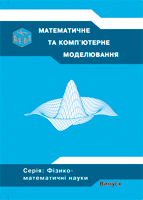Математичні методи і моделі кругової економіки (Презентація книги)
DOI:
https://doi.org/10.32626/2308-5878.2019-19.17-21Анотація
Основная цель настоящей книги — детально раскрыть, прояснить и проиллюстрировать математическое обоснование теории Сраффы с помощью современной теории матриц и соответствующих фундаментальных теорем. Наша книга также является ответом на появившийся запрос на альтернативные подходы к пониманию реалий современной экономической деятельности.
Посилання
Nour Eldin, H. A., Emmenegger, J.-F., Nabout, A. A. Currency and Market Decisions. Decesion-Based Economy. 2019.
Sraffa P. Warenproduktion mittels Waren (aus dem Englischen ubersetzt mit einem Anhang von B. Schefold), Edition Suhrkamp 780, Erste Auage. 1976.
Miller R. E., Blair P. D. Input-Output Analysis, Foundations and Extensions. Cambridge University Press, 2nd edition. 2009.
Carré H. NACE Rev. 2, Statistical classification of economic activities in the European Community. General and regional statistics, Methodologies and working papers, European Community. 2008.
Norlund L. Eurostat Manual of Supply, Use and Input-Output Tables. Luxembourg: Office for Official Publications of the European Community. 2008.
Ashmanov S. A. Introduction in Mathematical Economics (in Russian language). Moscow : Nauka, 1984. 296 p.
Leontief W. W. Die Wirtschaft als Kreislauf. Archiv für Sozialwissenschaft und Sozialpolitik. 1928. Vol. 60. P. 577–623.
Sraffa P. Production of Commodities by means of Commodities. Cambridge : Cambridge University Press. 1960.
Kurz H. D., Salvadori N. Theory of Production. A Long-Period Analysis. Cambridge University Press, paperback. 1995. 2007.
Frobenius G. Über Matrizen aus nicht negativen Elementen. Berliner Bericht. 1912. P. 456–477.
Pasinetti L. L. (ed.). Essays on the Theory of Joint Production. New York : Columbia Univ. Press 1980.
##submission.downloads##
Опубліковано
Номер
Розділ
Ліцензія
Authors who publish with this journal agree to the following terms:- Authors retain copyright and grant the journal right of first publication with the work simultaneously licensed under a Creative Commons Attribution License that allows others to share the work with an acknowledgement of the work's authorship and initial publication in this journal.
- Authors are able to enter into separate, additional contractual arrangements for the non-exclusive distribution of the journal's published version of the work (e.g., post it to an institutional repository or publish it in a book), with an acknowledgement of its initial publication in this journal.
- Authors are permitted and encouraged to post their work online (e.g., in institutional repositories or on their website) prior to and during the submission process, as it can lead to productive exchanges, as well as earlier and greater citation of published work (See The Effect of Open Access).

